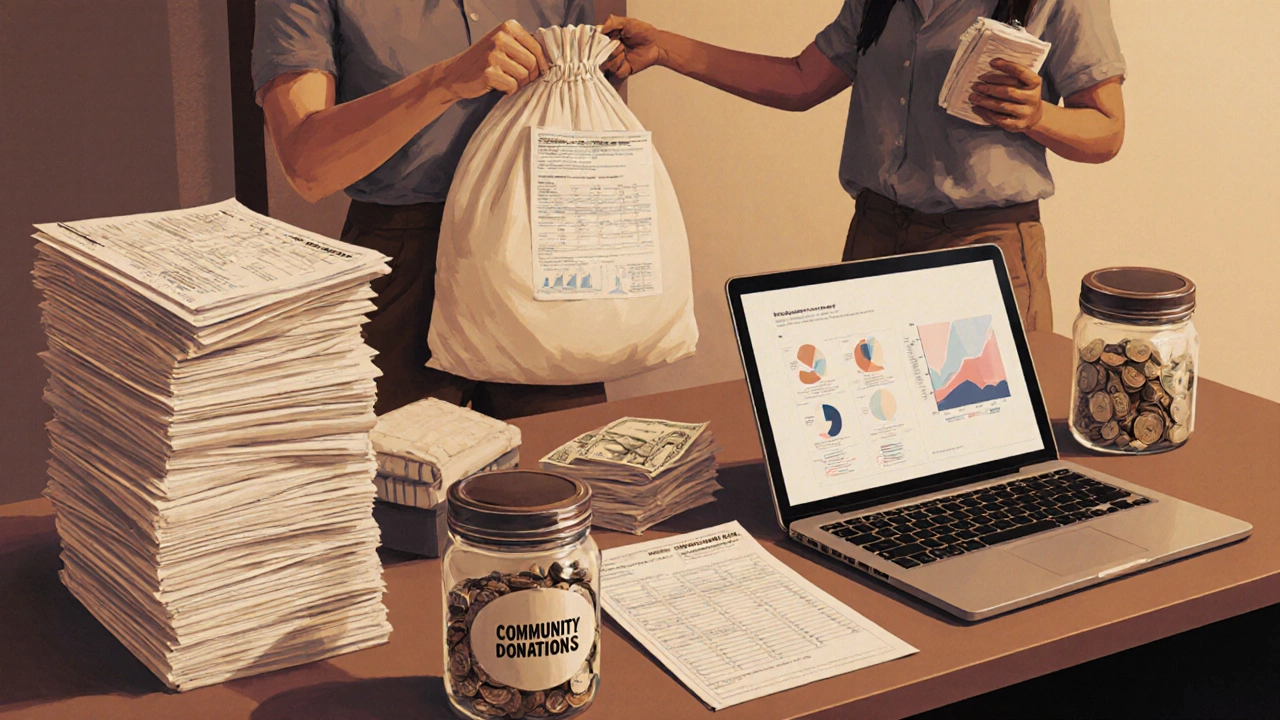Charitable Giving Calculator
How Much Should You Give?
This calculator compares your charitable giving to income-based patterns found in the article "Rich vs Poor: Who Donates More to Charity?"
The data shows that while wealthy donors give more in absolute dollars, low-income donors typically give a higher percentage of their income.
Enter your income to see comparison
How this works:
Low-income donors (bottom 50%) typically give 2-5% of income, with an average of 3.5%. Wealthy donors (top 10%) typically give 0.5-1% of income, with an average of 0.75%.
When you think about Charitable giving is the act of donating money, time, or resources to help others, the image of a billionaire’s gala often pops up first. But a massive, steady stream of support also comes from people living paycheck to paycheck. The question "who gives most to charity, rich or poor?" isn’t as simple as comparing bank statements - it involves total dollars, percentage of income, motivations, and the ways tax rules shape behavior.
- Rich households pour more absolute dollars into charities, but they donate a smaller slice of their income.
- Low‑income households give a higher share of what they earn, even though the dollar amount is modest.
- Both groups are driven by personal values, social pressure, and, for the wealthy, tax incentives.
- Misconceptions about "the poor don’t give" hide the real impact of community‑level philanthropy.
- Understanding these patterns helps nonprofits design campaigns that resonate across the income spectrum.
How Researchers Measure Charity Giving
Data comes from household surveys, tax records, and nonprofit reports. The most cited source in the U.S. is the Survey of Consumer Finances, which asks families about charitable donations for the previous year. In the UK, the Charity Commission’s Annual Report provides similar breakdowns. These studies track both cash gifts and in‑kind contributions (like food drives or volunteer hours).
What the Numbers Tell Us
Across the OECD, the top 10% of income earners are responsible for roughly 60‑70% of total charitable dollars. In the United States, the 2023 Giving USA report showed that households earning over $200,000 contributed an average of $12,500 each, totaling about $86billion. Meanwhile, the bottom 50% of earners (those making under $45,000) gave an average of $250 - a tiny $2billion overall.
When you flip the lens to “percentage of income,” the picture changes dramatically. Low‑income families tend to donate 2‑5% of their earnings, while the wealthiest give closer to 0.5‑1% of their massive incomes. That means a family earning $30,000 might give $600 in a year, which feels huge relative to their budget, whereas a $1million household might donate $10,000 - a far smaller slice.
Why Wealthy Donors Give (and How Tax Incentives Play In)
Wealthy donors often cite legacy building, network influence, and strategic impact as top motivations. A 2022 study by the Rockefeller Philanthropy Advisors found that 78% of high‑net‑worth individuals view giving as a way to shape public policy or support causes aligned with their business interests.
Tax rules matter a lot. In many countries, charitable contributions are deductible from taxable income, effectively reducing the after‑tax cost of a donation. For a donor in the 37% marginal tax bracket in the U.S., a $10,000 gift can feel like a $6,300 out‑of‑pocket expense. This tax incentive nudges wealthier people to give larger absolute amounts, especially to foundations that can leverage matching grants.

Why Low‑Income Donors Contribute
Low‑income donors often support causes that touch their own lives: food banks, community shelters, and local schools. A 2021 Urban Institute survey revealed that 62% of respondents earning under $30,000 said they give because "it’s the right thing to do for my neighbors." Social cohesion and religious affiliation also play strong roles; in neighborhoods where churches or community groups organize donation drives, participation spikes.
Even without tax breaks, the emotional payoff of helping a neighbor or seeing a child benefit from a program can outweigh the financial strain. Many low‑income contributors also give in‑kind (clothing, food) rather than cash, which isn’t always captured fully in dollar‑based statistics.
Rich vs Poor: Side‑by‑Side Comparison
| Metric | Wealthy Donors (Top 10%) | Low‑Income Donors (Bottom 50%) |
|---|---|---|
| Average annual donation (cash) | $12,500 | $250 |
| Average % of income donated | 0.6‑1% | 2‑5% |
| Preferred donation type | Foundation grants, endowments | In‑kind items, local food banks |
| Primary motivation | Legacy, influence, tax benefits | Community support, faith, personal values |
| Impact visibility | High (publicized events, naming rights) | Low (quiet, local contributions) |
Common Myths Debunked
Myth 1: "The poor don’t give because they can’t afford it." The data shows they do give - often as a larger share of their income. Their contributions may be invisible in big‑donor reports, but they keep community services alive.
Myth 2: "Rich donors are purely self‑interested." While tax incentives and legacy goals play a role, many wealthy philanthropists express genuine altruism and cite personal experiences that drive their support.
Myth 3: "Only cash matters." In‑kind donations from low‑income families (clothes, meals) can be worth millions in aggregate, especially during disaster relief.

How Nonprofits Can Engage Both Groups
Understanding these patterns lets charities tailor appeals. For wealthy donors, highlight impact metrics, naming opportunities, and tax‑deduction information. For low‑income supporters, keep giving channels simple, emphasize community benefit, and recognize contributions publicly - even a thank‑you note on a local bulletin can boost morale.
Digital platforms also level the playing field. Crowdfunding sites let anyone give a dollar and see the collective result, while donor‑advised funds let high‑net‑worth individuals allocate money quickly and strategically.
Next Steps for Readers
- Assess your own giving habits. Track the percentage of your income you donate, not just the dollar amount.
- If you’re a nonprofit leader, audit your donor database to see which income brackets are under‑represented.
- Consider partnering with local businesses or community groups to create joint fundraising events that attract both wealthy sponsors and neighborhood volunteers.
- Advocate for policy changes that expand tax credits for low‑income donors, making it easier for them to give.
Frequently Asked Questions
Do rich people give a higher percentage of their income than poorer people?
No. While they donate more money overall, the percentage of income they give is usually lower than that of low‑income households, which often allocate 2‑5% of their earnings.
How much of total charitable dollars come from the bottom half of earners?
Across most developed economies, the bottom 50% of earners contribute roughly 5‑10% of total charitable cash donations, though their in‑kind contributions can raise that impact.
Are tax deductions the main reason wealthy people give?
Tax benefits are a significant incentive, but surveys show legacy building, personal values, and strategic influence are equally important drivers.
Can small, regular donations make a real difference?
Absolutely. When many people give modest amounts, the cumulative effect can fund large programs, especially in community‑based charities that rely on steady streams of support.
What are effective ways to encourage low‑income donors?
Simplify donation methods (mobile payments, cash drop boxes), publicly recognize contributions, and tie appeals to immediate community benefits.





